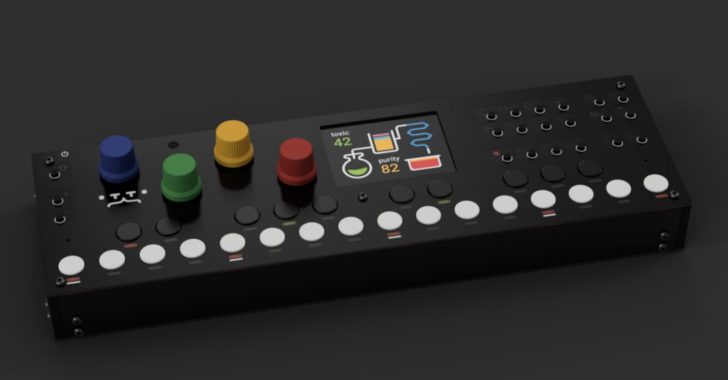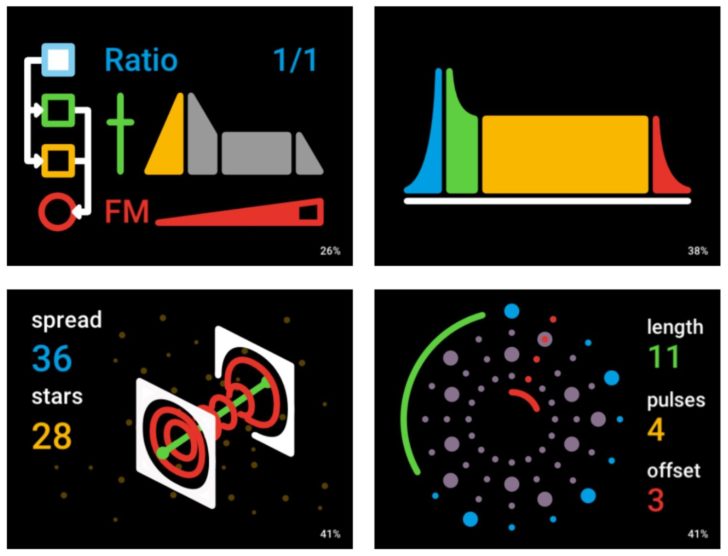
The OTTO is a new open-source portable sampler, synth and sequencer, originally inspired by the Teenage Engineering OP-1.

Lead designer Tobias Pisani says that “The interface is modular, easy to use, simple, but most of all, it encourages experimentation. The graphics are quirky, and the workflow is minimal.”
Here’s what Pisani has to say about the current state of the project:
Main OTTO dev here!
This render (above) is what is actually happening for the first prototypes (provided nothing goes terribly wrong).
The software is at this point pretty far along, but there’s gonna be a lot of work in coding for this new hardware, and getting everything working.
Its gonna take some time, but we’re getting there.
Regarding the clear OP-1 similarities, obviously we are heavily inspired by it. But if you want an OP-1, this is not it. It takes quite a different direction, and the only things that are really like the OP-1 are the graphics style and basic interaction model. The workflow will be very different, the individual synth/fx engines have nothing to do with the OP-1 ones, and the OTTO would take up a separate spot in your setup.
It’s much more of a groovebox than the portable production beast that is the OP-1.
Here’s a preview of the OTTO Sampler interface:
Here’s a preview of OTTO’s Nuke synthesizer:
Details on the project are available at the OTTO Github site.

That looks pretty amazing! Really hope it ends up as an actual product.
Perhaps this was another reason for the price increase of the OP-1. Trying to squeeze the last juice out of the op-1 b4 it’s surpased by another product.
That’s not how markets work. If they expect competition, it would make more sense to drop prices to increase barriers to entry. Raising the price creates more opportunity for competitors, not the other way around.
It depends. If a business has hopes of surviving the competition, then yes. If the business knows its days are numbered it may seek to maximize profit with the time it has left (i.e., grab the cash and head for the exit). As to whether TE is price gouging or just dealing with the consequences of a lack of foresight when designing and sourcing parts, I have no idea. And of course it could be some combination of both.
Dropping prices in response to competition is what adults do, not teenagers.
Hormones….
@Serve, maybe or maybe not, Kevin makes an excellent point above my reply and in other forums the price increase has been explained by TE as increased material and production costs. Over the years these factors have increased in all areas, not just for TE. They have also had to source a different screen as the previous screen is no longer available, so that is probably another increased cost for development and manufacture.
As for “surpassing” something like the OP-1? How do you do that, what does surpass even mean in terms relevant to units like these? The OP-1 is very much it’s own unique beast. For example, did the Voyager “surpass” the Model-D? No, of course not, they each should be judged on their own merits.
Anyway, it’s obviously not the case here anyway, it’s stated fairly clearly:
“Regarding the clear OP-1 similarities, obviously we are heavily inspired by it. But if you want an OP-1, this is not it. It takes quite a different direction, and the only things that are really like the OP-1 are the graphics style and basic interaction model. The workflow will be very different, the individual synth/fx engines have nothing to do with the OP-1 ones, and the OTTO would take up a separate spot in your setup.
It’s much more of a groovebox than the portable production beast that is the OP-1”
sounds like an amateur pure data patch
So they beat Behringer to it…
COUNT ME IN YALL
looks awesome!
A “mutable” OP-1? I’m definitely interested!
I’m sorry, but that thing looks truly terrible. Like a ‘busy box for baby’. The designers need to go away and study Dieter Rams for a bit- if they’ve ever heard of him? And learn to code: because it does sound like Pd.
what’s wrong with pd?
Pd can sound great, but it does take a certain degree of skill and effort to make that happen. The sound transformations explored in these demos appear like many ‘first synth’ pd patches.
I, personally, like the design of this thing.
But what i like most, is that when i will DIY this, it should cost me a fraction of OP-1.
If you like to pay 1300 USD for a “nicely desgned and coded” piece of gear…well – go for TE stuff.
It doesn’t look that different from an alternate universe black OP-1. Honestly, the snobbery of people in here sometimes…
i’m pleased at least someone appreciates the toothpaste tube cap knob aesthetic
Its a DIY project. It literally means you can pick up any kind of caps you want.
i’m simply commenting based on what i see in front of me. before name calling folks (as ‘snobs’ or whatever) it’s worth first considering the actual substance of their criticisms. i mean sure i could fire up the CNC and mill some nice parts from aluminum. . . but why bother?
Because its a nature of DIY. Many folks, including me, are literally building their own versions of music gear. And you dont need a CNC: there are tons of nice customizable caps you can buy, for example from Cliff brand.
lol i’m not denying you can’t purchase a variety of knobs for your pots.
if one is to DIY their own instrument, why go for such an obvious rehash of a pretty limited commercial device? why not inject actual creativity into the design from the ground up? does the world need another small box with knobs and led screen? why not explore new modes of interaction? the real allure of DIY (for me) is that you can develop new potential avenues of creative exploration that commercial companies can’t (or are demonstrably unwilling to).
and to be honest i don’t actually care, about neither this project, nor its commercial inspiration. i just find it bizarre that people on this site (admittedly, not you) are calling others names (‘snobs’ etc) for levelling perfectly valid criticism. and also strange that (admittedly, you), are continuing to defend this approach without targeting the actual substance of the posters criticism.
and anyway, if one is to actually spend months constructing something like this, at least make it sound decent at first. a raspberry pi running pd/supercollider/csound etc and random midi knob box can be thrown together in an afternoon to sound infinitely better than this thing. . . & it won’t look much worse neither.
i just don’t get how this could be exciting to anyone, except obviously to the DIY synth bro fist pump crowd which is unfortunately all too prevalent in the modern computer music scene and particularity evident on this site.
Such huge aching butt hurt and not a word on the new modes of interaction that could be explored. Oh the wonderful ease of criticism, so much easier to elevate yourself above the hard work of others instead of actively creating something from scratch yourself. ?
lol more insults & not a single direct reply to the criticisms presented in the discussion.
i am attempting to engage the poster’s in a conversation on the merits of technical meandering for technical meandering’s sake. if it’s not possible to have a dynamic critical discussion on this public forum i’ll stop posting. but i think every critique i made in my post is perfectly fair and still worth considering.
i’m not going to link my personal works here. but as you asked, here are three intriguing projects that consider new modes of interaction & a take a critical approach to technology in the context of musical instrument creation & performance:
cod.act : pendulum choir
https://www.youtube.com/watch?v=vsXs3GUrw64
messier : field
https://www.youtube.com/watch?v=SaS_zthoHWk
ei wada : open reel ensemble
https://www.youtube.com/watch?v=LIpLfxys3ik
Cool I guess, but nothing that I can put in my pocket. And the most interesting of them is just turntablism with tape. Not exactly a new mode of interaction.
My hope on this is for it have standard MIDI ports. If they also want USB MIDI that is fine, but it was the main reason the OP-1 didn’t attract me at all. (I’m also a CV/Gate fan, but these digital things scream MIDI.)
It will have TRS jacks as MIDI ports, according to the new standard.